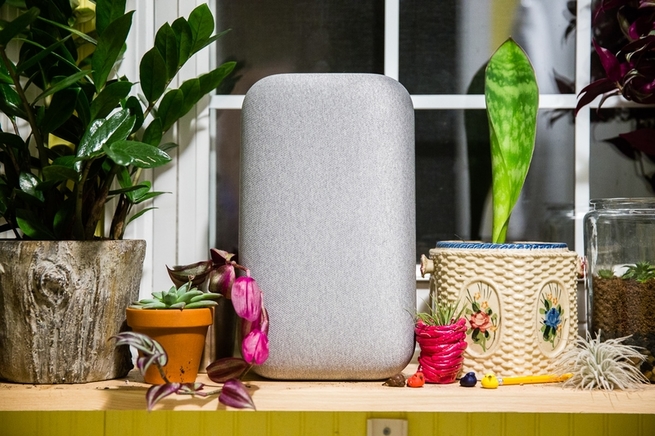

We may earn revenue from the products available on this page and participate in affiliate programs. Learn more ›

Today, Google rolled out a new ability for the Google Assistant. The helpful, disembodied entity that lives inside smartphones and Google Home devices can now interpret two languages at the same time, including French, German, Japanese, Spanish, Italian and English. It’s a useful new function for the Google Home, especially as the number of multilingual homes increases. But, how will users know about it?
It’s a question I recently encountered in my own personal experience.
A few weeks ago, the familiar command that turns my Philips Hue lights on and off stopped working.“OK, Google, turn off the light in the living room.” The lights didn’t budge. I spent 20 minutes repeating the command and digging into the Google Home app, which I hadn’t opened in quite some time—after all, that’s why I have a voice assistant in the first place, right?
Hearing my repetitive commands, my wife yelled from upstairs, “You have to say ‘turn off the living room lights’ now—plural. It updated” She was right. It worked.
All of this raises an important question about how we communicate with our digital assistants: How do we know when a voice assistant updates and changes the commands we rely on to trigger actions that are increasingly central to our daily routines? It’s still a work in progress.
Keeping up with the updates
“In general, our strategy is to launch updates through experimentation, which we use to understand how users respond to new features we add to the product,” Prabhu Balasubramanian, Product Manager on the Google Home team, says via email. “Experiments are running all the time, and the tests that yield good results are rolling out to all users on a regular basis.”

I asked both the Alexa and Google Assistant teams how to find out about updates to their digital assistants. It came down to three basic methods:
Subscribe to a newsletter that shares new features
Monitor new abilities through updates in the companion apps
Ask the assistants directly what’s new
For Alexa, this means signing up for the Echo newsletter, visiting the Things to Try section of the app, or asking specifically, “Alexa, what are your new features?” or “Alexa, what are your new Skills?” That wording comes straight from Amazon.
For Google Home, you can sign up for the email newsletter, check the Discover tab in the Home app, or or directly ask, “Hey Google, what can you do?” Google also suggests you could pay attention to its marketing campaigns to learn about new features in Assistant. Nice try!
Siri updates, however, are more closely tied to iOS updates, which you can monitor via the app store, whether it’s on your phone or your computer.
A little more conversation
The companies behind the assistant believe, to an extent, that the solution lies in a more regular and human-like conversation between users and assistants.
“The data clearly shows that people expect a much more conversational experience with the Assistant than with Google Search” says Balasubramanian, citing a Google blog post. “Assistant queries are 200 times more conversational than on Search. We think this is a trend that will continue, as people’s expectations for the Assistant continue to go up.” Instead of users barking questions and commands as they would type them, digital assistants are increasingly designed for human-style interaction.

This push toward conversational interactions is already in the works and making Google Assistant better. In fact, the update that changed the way my lights work also made it so I can now ask the lights to perform several commands in a row. Now that I understand it, it’s great, but the communication breakdown made it painful.
Interestingly, Amazon specifically includes features and commands meant to be discovered by trial and error. “We are still at the very tipping point of conversational AI and we’re far off from achieving a true human-to-human interaction,” an Amazon rep said via email. “But it’s exciting – even just for the future of AI—to see customers reacting to Alexa in this way, and we’re working hard on even the little responses, Easter eggs and nuances to make Alexa more personable, humble and helpful every day.” Sure, there’s a lot of marketing speak in there, but it clearly lays out the fact that Amazon sees these “discoveries” as a fundamental part of conversing with Alexa.
It’ll get more complicated before it gets simpler
While the digital assistant companies are honing their strategies, smart homes provide a rather large set of variables they need to address. The assistants need to update, but so do the devices they control. Every couple months I get the somewhat surreal experience of updating the lightbulbs in my house—a process which involves blasting every light source in my home while waiting for a progress bar to crawl across an app screen. When it’s done, it can be unclear how the updated software will interact with the digital assistant meant to boss it around.
In the future, it seems a safe bet that you can expect the assistants to talk more. The “sorry, I can’t do that right now,” message could eventually expand into more helpful statements with suggestions for possible solutions or diagnostic information about the problem. For now, your best bet is still to keep up the old fashioned ways if you want to get the most out of your smart assistant. And don’t get too attached to the commands you say every day—because they might change and you’ll find yourself yelling at a light switch at 11:30 PM on a school night.
